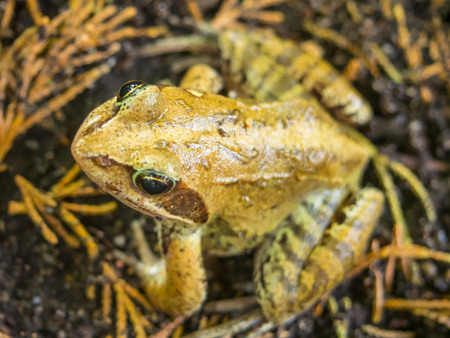1. Understanding Amphibian Dietary Needs
When it comes to feeding exotic amphibians like frogs, salamanders, and axolotls, understanding their unique dietary needs is key to keeping them healthy and happy. These creatures have evolved in different environments and have specific nutritional requirements that are influenced by what they eat in the wild.
The Basics of Amphibian Nutrition
Amphibians are carnivorous for most of their lives, especially as adults. In nature, they feed on a variety of live prey including insects, worms, small fish, and even tiny crustaceans. Their diets provide them with essential proteins, vitamins, and minerals needed for growth, development, and reproduction.
Wild Diets vs. Captive Diets
In the wild, frogs might hunt crickets or flies, salamanders may snack on earthworms or slugs, while axolotls often catch aquatic insects or small fish. However, in captivity, we need to mimic these diets as closely as possible with available foods that are safe and nutritious.
Common Food Items for Exotic Amphibians
| Species | Wild Diet Examples | Captive Diet Options |
|---|---|---|
| Frogs | Insects (flies, crickets), spiders | Crickets, mealworms, waxworms, fruit flies |
| Salamanders | Worms, slugs, snails | Earthworms, bloodworms, blackworms |
| Axolotls | Aquatic insects, small fish | Nightcrawlers, pellets designed for axolotls, frozen bloodworms |
Nutritional Balance and Supplementation
Because captive environments can’t always provide the same variety as the wild, it’s important to offer a mix of foods and sometimes use supplements like calcium or vitamins to prevent deficiencies. Dusting feeder insects with calcium powder is common practice for frogs and salamanders. For axolotls, choosing high-quality pellets along with occasional live or frozen treats helps ensure they get everything they need.
2. Choosing the Right Foods
Safe and Healthy Diets for Frogs, Salamanders, and Axolotls
Feeding your exotic amphibian the right foods is key to keeping them healthy and happy. Different species have different dietary needs, so it’s important to know what’s safe and nutritious for your pet. Here’s a guide to common feeder insects and commercial diets that are popular with amphibian keepers across the US.
Feeder Insects: What’s on the Menu?
Most frogs, salamanders, and axolotls thrive on a diet of live insects. These mimic what they would eat in the wild and offer essential nutrients. Below is a table showing some of the most popular feeder insects and which amphibians they’re suitable for:
| Feeder Insect | Frogs | Salamanders | Axolotls | Notes |
|---|---|---|---|---|
| Crickets | Yes | Yes | No | Mainstay for many frogs and salamanders. Gut-load before feeding. |
| Mealworms | Yes (occasionally) | Yes (occasionally) | No | High in fat; use as treats. |
| Earthworms/Nightcrawlers | Yes | Yes | Yes | A favorite for axolotls; good protein source. |
| Drosophila Fruit Flies | Yes (small frogs) | Yes (juveniles) | No | Great for baby or small amphibians. |
| Black Soldier Fly Larvae (CalciWorms) | Yes | Yes | No | Rich in calcium; helps prevent deficiencies. |
| Bloodworms (Frozen/Live) | No | No | Yes | Main food for juvenile axolotls; can be messy. |
| Tubifex Worms (Frozen/Live) | No | No | Yes (occasionally) | Treat only due to potential contamination risks. |
Commercial Diets: Are They a Good Choice?
If you can’t provide live food all the time, there are commercial diets made especially for amphibians. These come in pellets or gel forms and are formulated to meet their nutritional needs. Some popular options available in US pet stores include:
- Pelleted Axolotl Food: Specially designed for axolotls, these sink to the bottom of the tank and contain balanced nutrients.
- Tadpole Pellets: For young frogs or tadpoles; look for products without artificial colors or flavors.
- Sinking Amphibian Pellets: Suitable for aquatic salamanders or newts; always check the ingredients list.
- Nutritional Gels: Easy-to-use gels that can be cut into bite-sized pieces—great for picky eaters or as a supplement.
The Importance of Variety and Supplements
No matter what you feed, variety is important! Rotating between different types of safe feeders ensures your pet gets a range of nutrients. Dusting feeder insects with calcium powder is also recommended at least 1-2 times per week, especially for young, growing amphibians.
Quick Tips for Feeding Success:
- Avoid wild-caught insects—they might carry pesticides or parasites.
- Never feed fireflies, centipedes, or other toxic bugs.
- If using commercial diets, always follow package instructions.
- Certain amphibians may refuse non-moving food at first—be patient!
- Cater meals to your pet’s size; avoid offering food larger than their mouth.
Selecting safe and healthy foods will help your exotic amphibian stay active and vibrant, whether you’re caring for a lively tree frog, a colorful salamander, or an adorable axolotl!

3. Feeding Schedules and Portion Control
Understanding how much and how often to feed your exotic amphibian is just as important as choosing the right foods. Frogs, salamanders, and axolotls all have unique needs that depend on their species, age, and environment. Overfeeding can cause health problems like obesity or water quality issues in aquatic habitats, while underfeeding can lead to malnutrition and stunted growth.
How Often Should You Feed Your Amphibian?
The frequency of feeding varies by species, age, and activity level. Here’s a general guideline for common pet amphibians:
| Amphibian Type | Juveniles | Adults |
|---|---|---|
| Frogs (e.g., Pacman Frog, Tree Frog) | Daily or every other day | 2-3 times per week |
| Salamanders (e.g., Tiger Salamander) | Every 1-2 days | 2-3 times per week |
| Axolotls | Daily or every other day | 2-3 times per week |
Tip: Always observe your pet’s behavior—if they leave food behind regularly, you may be offering too much or feeding too often.
How Much Should You Feed? Portion Sizes Explained
A good rule of thumb is to offer enough food that can be eaten within 15-20 minutes. For most amphibians, this means:
- Frogs & Salamanders: 2-5 appropriately-sized insects or prey items per meal (smaller animals may need less)
- Axolotls: 1-2 earthworms or a small handful of pellets per meal (adjust based on size)
If you’re feeding live prey, choose items that are no larger than the space between your pet’s eyes to avoid choking risks.
Special Considerations: Age, Species, and Environment
- Juveniles: Growing amphibians need more frequent meals with higher protein content for proper development.
- Species Differences: Some species have faster metabolisms or are more active hunters than others—always research your specific pet!
- Environmental Conditions: Cooler temperatures slow metabolism; you may need to reduce feeding frequency during winter or in cooler tanks.
- Aquatic vs Terrestrial: Aquatic species like axolotls often eat more at once but less frequently; terrestrial species might prefer smaller, more regular meals.
Your Amphibian’s Appetite May Change!
If your frog, salamander, or axolotl suddenly eats less or refuses food, check environmental factors like water quality and temperature first. Appetite changes can signal stress or illness as well. When in doubt, consult a veterinarian with experience in exotic pets.
4. Supplements and Gut-Loading
Why Supplements Matter for Amphibians
Feeding your exotic amphibian is more than just dropping in crickets or worms. Frogs, salamanders, and axolotls often need extra nutrients to stay healthy, especially when they’re kept as pets in the U.S. Many feeder insects and store-bought foods don’t provide enough calcium or vitamins on their own. Without proper supplements, your amphibian could develop weak bones, muscle problems, or even life-threatening health issues.
The Essential Supplements: Calcium & Vitamins
| Supplement | Why It’s Important | How Often to Use | Common Sources |
|---|---|---|---|
| Calcium | Prevents metabolic bone disease; supports strong bones and normal muscle function. | 2-4 times per week (varies by species) | Calcium powder without phosphorus or with vitamin D3 |
| Vitamin D3 | Helps absorb calcium; especially important for amphibians without UVB light exposure. | 1-2 times per week (with calcium supplement) | Combined in some calcium powders |
| Multivitamin | Covers other essential vitamins and trace minerals not found in basic diets. | Once a week | Reptile/amphibian multivitamin powders |
How to Dust Feeder Insects with Supplements
Dusting is simple: Place your feeder insects (like crickets or mealworms) in a plastic bag or cup with a small amount of supplement powder. Gently shake until the bugs are coated. Then feed them to your amphibian right away so the powder doesn’t fall off. Most American pet owners find this method easy and effective for frogs, salamanders, and axolotls alike.
The Importance of Gut-Loading Feeder Insects
Gut-loading means feeding your insects a nutritious diet before offering them to your pet. Well-fed bugs become more nutritious themselves—passing along those benefits to your amphibian. This is especially important in the U.S., where commercially bred insects may be raised on low-nutrient diets.
Gut-Loading vs. Regular Feeding: What’s the Difference?
| Regular Insects | Gut-Loaded Insects | |
|---|---|---|
| Nutritional Value | Poor/Incomplete | Rich/Complete |
| Benefit to Amphibians | Lacking in vitamins/minerals | Packed with nutrients from fresh produce and supplements |
| Lifespan & Health Support | May cause deficiencies over time | Supports long-term health and vitality |
The Best Foods for Gut-Loading Insects in America
- Leafy greens (collard, mustard, dandelion)
- Carrots and sweet potatoes (chopped or grated)
- High-quality commercial cricket diets (available at most U.S. pet stores)
- A little bit of fruit like apple or orange for added vitamins—but not too much!
If you make gut-loading a regular part of your care routine, you’ll help ensure your frog, salamander, or axolotl gets everything it needs to thrive—just like they would in the wild.
5. Addressing Common Feeding Challenges
Picky Eaters: How to Encourage Better Eating Habits
It’s not unusual for exotic amphibians like frogs, salamanders, and axolotls to become picky eaters—especially after a change in environment or routine. Many American pet owners find their amphibians refusing new foods or only eating their favorites. To help your pet get a balanced diet, try these simple strategies:
- Offer Variety: Rotate between different feeder insects (crickets, earthworms, black soldier fly larvae) to stimulate interest.
- Gut-Load Insects: Feed nutritious veggies to live insects before offering them to your amphibian—this boosts the nutritional value.
- Use Scent and Movement: Some amphibians respond better to wriggling prey; use feeding tongs to mimic natural movement.
- Timing: Offer food during your amphibian’s most active hours (usually evening for many species).
Nutritional Deficiencies: Spotting and Preventing Issues
Amphibians need a varied diet to avoid nutritional problems like metabolic bone disease, vitamin deficiencies, or obesity. Here’s a quick reference table for common deficiencies and solutions:
| Deficiency | Common Symptoms | How to Fix It |
|---|---|---|
| Calcium | Lethargy, weak bones, deformities | Add calcium powder (without phosphorus) to feeder insects 2-3 times a week |
| Vitamin D3 | Poor appetite, sluggishness, bone issues | Use calcium with D3 supplement if using artificial lighting; provide UVB light for diurnal species |
| Vitamin A | Swollen eyes, poor skin health, low activity | Include gut-loaded insects rich in vitamin A or use reptile/amphibian-safe vitamin supplements as directed |
| Obesity | Lethargy, bloating, trouble moving | Limit fatty foods like waxworms; stick to leaner prey and control portion size |
Transitioning Wild-Caught Amphibians to Captive Diets
If you’ve adopted a wild-caught frog or salamander (note: check local laws about collection), transitioning them to a captive diet can take patience. Many are used to specific wild prey that isn’t available in the U.S. pet trade. Here are some tips tailored for American keepers:
- Mimic Natural Diets: Research what your species eats in the wild and find similar feeders (for example, earthworms are widely accepted by most amphibians).
- Scent Transfer: Rub store-bought prey on a familiar wild food item to transfer scent—this can entice reluctant eaters.
- Tong Training: Use tweezers or tongs to gently wiggle food near your amphibian’s face; this simulates live prey movement.
- Gradual Change: Mix small amounts of captive food with familiar items at first, slowly increasing the amount over several feedings.
- Avoid Force-Feeding: Stress can make feeding issues worse. Be patient—most amphibians will adjust within a few weeks when offered food regularly.

